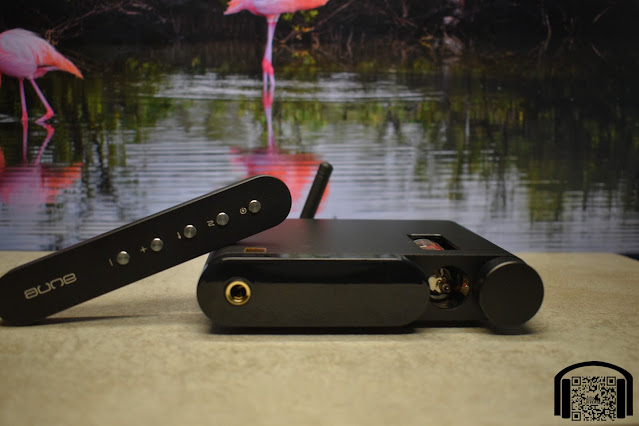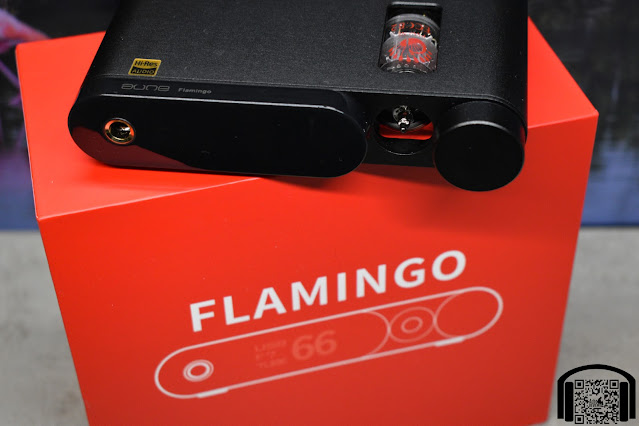- Get link
- X
- Other Apps
English | Español
TLDR version on YouTube: TDLR - Aune Flamingo
The Aune Flamingo has been sent to me directly by Aune in exchange for the publication of this review. They have not made any specific requests and in fact have been quite patient as I received the unit before the end of 2022 and have not had a chance to actually review it until now.
As always, I will do my best to be as sincere and unbiased as humanly possible but it is always good to consider the fact that it has not cost me anything to try this unit.
The official page for the Aune Flamingo can be found here: https://www.aune-store.com/en/aune-flamingo-tube-dac-headphone-amp_110301_1177/
For those located outside Europe, the Flamingo is available on Amazon US here: https://www.amazon.com/dp/
(Non-affiliate links, as always).
Intro…
The first time I saw (and tried) the Flamingo was back in May 2022 at High End Munich. At the time it wasn’t even called the Flamingo and it wasn’t until Aune offered to send me the device that I realized that I had actually seen it before.
The Flamingo is a DAC/Amp combo that offers two different preamplification modes to select between tube and op-amp. While this is not the first time something like this has been done, it is not very common and it is a nice feature to see on a product that is at a very reasonable price point.
The Flamingo is available with or without Bluetooth connectivity and can also be operated via a remote control which is sold separately. The version I have been testing has both BT and the remote control, so I will be mentioning those along the way.
Presentation…
The box that the unit arrives in is a nice bright red with FLAMINGO in large white letters and a simple outline drawing of the device on the top. It is a very simple presentation but is enough to draw attention to itself.
Inside the box we find the Flamingo with the tube already installed, a quick start guide, a USB-A to USB-B cable, a USB-C to USB-B adapter, a 3.5mm to 6.35mm adapter and the power supply. In my case I also received two Bluetooth antennas and the remote control.
This is plenty to get the Flamingo up and running. While it may sound like something trivial, I appreciate the USB-C to USB-B adapter as it allows me to use some of the cables that I already have in place in certain locations, allowing me to test the Flamingo in multiple locations without much hassle.
Build and aesthetics…
The Flaming is a rather compact device with rounded edges and a nice large and simple to read screen on the front. The tube is recessed into the unit which will save it from the risk of getting knocked and broken (unless something is dropped directly on it from above) and while I wouldn’t recommend stacking things on top of it (tubes get hot), it does mean that it will fit almost anywhere.
The device is well assembled and I like the aesthetics as they are a little different to many other devices, giving it a bit of a unique look.
The screen features white numbers and text, displaying the volume level in a large digits with the input, filter and tube/op amp being displayed to the left. All of this information is easily readable both from a distance and from any angle (within reason of course).
The remote control is also something I am quite fond of. It is completely made of aluminum and is not just another typical remote. It is long and thin, with a single line of buttons down the center, 5 in total, that feel sturdy and respond well. It is a shame that it is not included with every unit but I do understand that not everyone needs/wants a remote.
In general, I am very happy with the build and aesthetics of the Aune Flamingo.
Functionality…
Let’s start off with a look at the layout of connections and controls (well, control really, as there is only one).
On the front there is a 6.35mm unbalanced headphone output to the left of the screen and a large rotary knob on the right. Moving around to the back of the device, we have the RCA analog outputs on the left, followed by a coaxial input (RCA), then the USB-B connector, the connection point for the Bluetooth antenna (in the case of a Bluetooth device), a DC 12V input and a mains on off switch.
The back is self explanatory, connect the analog outputs to an external amplifier or powered speakers if desired, connect the Coax input or the USB input (or both), screw in the antenna (packed separately) and plug in the power supply. Switch the power on and away we go.
The front is even simpler. Connect your headphones to the headphone output and then use the rotary dial for everything else.
Turn the dial to raise or lower volume, press the dial to cycle between USB or Coax input, double press to change between Tube to OpAmp, or hold to enter the filter menu. Once in the filter menu, turn to cycle through the 7 filter options and then press to select.
That is it as far as functionality from the device itself, very simple but even simpler if using the remote control. In this case, the remote has a dedicated button for each function (input, filter, tube/OpAmp) and pressing the corresponding button will cycle through the options. There are then 2 additional buttons, one for vol+ and the other for vol-.
Sound…
Now, let’s get to the part that I find most difficult in the DAC/Amp reviews, explaining the sound while trying to judge if it’s really there or if I am just imagining it 😊
First off, I have to say that the Flamingo sounds good in both modes. I have no complaint as far as sound or performance. It is not overly harsh, it does not seem to bring out any negatives in the overall performance of any of my IEMs or headphones and in general, it is a pleasant sound signature to listen to.
I also need to say that if you are expecting a night and day difference between the Tube and OpAmp mode, you are not going to find it. There are some subtle differences but this is not like switching from a THX amp to a full blown tube amp. In fact, neither mode is going to reach the end of the spectrum that I would place those two different amplifier technologies in. The OpAmp is not overly sterile or clinical and the Tube mode is not overly warm and lush.
What I am trying to convey by this is that, while I may mention differences between the two modes, they are in fact quite similar and some exaggeration may be introduced by my sighted tests (in other words, the screen telling me it is in Tube mode may actually make me hear it more “tubey” than it actually is).
The Tube mode does seem to add a little more warmth in the low end to the ear, yet it doesn’t really. What is happening is that there is a little bit of a roll off into the subbass regions, moving the focus just a little towards the midbass, added to the slight increase of the tube harmonics, this can make things sound just a little warmer and “rounder” in these lower ranges. Again, the fact that it says “Tube” on the screen automatically equals added warmth but in this case there is just a touch of that smoothness in the lower end.
There is also a little more “sparkle” in the higher end when using the OpAmp mode, with Tube mode things are a little more subdued. I noticed this a bit more with planar headphones although that slight hint is still there with dynamics and also IEMs. It is not that Tube mode seems less detailed or rounded off in the treble, there is just a hint more of brilliance.
As far as power, the Flamingo has a fair amount yet I find that it is all located at the top end of the volume control. My listening levels are not really high (as I have mentioned plenty of times in the past) and I found that I was hitting 78 to 80 out of 99 when listening to the Arya v3, yet over 82 started getting too loud very quickly. Even with IEMs I found that I would be turning up way past the point I expected but then it would become too loud if I went just a couple of steps higher. This does limit the volume control range and while it is by no means short on power, I find that there isn’t a huge amount of fine adjustment due to this.
Conclusion…
I think that the Flamingo is a great little piece of equipment at a very reasonable price. It has a good sound, good amount of power and it lets you switch between pure OpAmp and a bit of that tube flavour just with a touch of a button (or two presses without the remote).
The Tube mode is not really that tubey, it is only really a hint and reminds me of something like the P20, where it is still a very clean sound even with tubes in the circuit. However, clean is not to be confused with cold, Find the FLamingo to have a very enjoyable sound for listening to music and I am more than happy to just plug into it an press play.
I do wish that the volume control was better distributed, rather than having most of the power at the top 20% but I think that is really my only complaint. I could say that it would be great to have balanced but I understand it not being balanced as an all in one at this price. Personally I would also like an optical input but the presence of Coaxial is enough, at least we are not only dependent on USB, so I am not going to complain there either.
I guess all I can say is that the Flamingo a good little all in one that will provide a lot of enjoyment on a desk for not a lot of money. What more can I really ask for?







